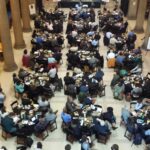 Katherine Lato, Maryanna Milton and Barry Glicklich went to the National Digital Inclusion Alliance (NDIA) conference in St. Paul, MN on May 16-17th. Slides from presentations are available at the above link. This is their joint report.
Katherine Lato, Maryanna Milton and Barry Glicklich went to the National Digital Inclusion Alliance (NDIA) conference in St. Paul, MN on May 16-17th. Slides from presentations are available at the above link. This is their joint report.
Our key takeaways:
- Don’t reinvent the wheel
- There isn’t a single path to using computer technology- find people’s interests and use projects to drive learning- e.g. knitting, then finding patterns.
- Engage those with outside perspective in digital inclusion- meet them where they are, using their language to identify how digital inclusion can help with their issues.
- Little involvement from federal agencies at this conference
- Teach people critical thinking while using computers, not just how to use a particular computer.
PRE-CONFERENCE
The activities began with a Monday evening social gathering sponsored by Mobile Beacon and PCs for People. We met digital inclusion proponents from Arizona, California, Minnesota, Illinois, Indiana, New  Mexico, North Carolina, DC, Alaska, Maine, Kentucky, Texas, Pennsylvania, New Jersey, and Australia. We made new connections, learned about initiatives, and met a number of folks doing digital work through Americorps. The Great Waters Brewing Company in Saint Paul had a good selection of craft beers and appetizers and the staff was very responsive. There are also a number of bridges in the twin cities, so we gathered more for our collection.
Mexico, North Carolina, DC, Alaska, Maine, Kentucky, Texas, Pennsylvania, New Jersey, and Australia. We made new connections, learned about initiatives, and met a number of folks doing digital work through Americorps. The Great Waters Brewing Company in Saint Paul had a good selection of craft beers and appetizers and the staff was very responsive. There are also a number of bridges in the twin cities, so we gathered more for our collection.
CONFERENCE – DAY ONE
On Tuesday morning, conference participants had their choice of three tours:
 Walking tour of Saint Paul. Maryanna went on this.
Walking tour of Saint Paul. Maryanna went on this.- Bus trip to two places in Saint Paul. Barry went on this.
- Bus trip to two sites in Minneapolis. Katherine went on this.
 WALKING TOUR
WALKING TOUR
Lac qui Parle Economic Development Authority Computer Commuter
The LqP Computer Commuter is a mobile computer lab that tours Lac qui Parle County to provide computer training and assistance to residents and local businesses especially in the communities of Bellingham, Boyd, Dawson, Madison, Marietta and Nassau. 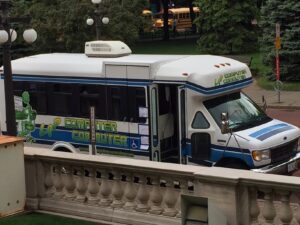 Many rural residents attend the lab to use the free WiFi and to learn more about their own technology devices.
Many rural residents attend the lab to use the free WiFi and to learn more about their own technology devices.
St. Paul Public Library
George Latimer Central
Workforce and Innovation (WIN) Lab: Free makerspace for adults who have an active library card and attend a required orientation. Equipment includes: laptops with creative software (Adobe creative cloud, Blender, NetFabb 3d design,), camera, 3D printer, DVD/VCR combo (with software to convert), sewing machine, and an equipped private recording/mixing studio. Open Lab: Staffed by AmeriCorps. Hours vary by location. One on one computer instruction and assistance.
Computer/technology Classes: Multi session classes. Use the North Star Digital Literacy Assessment and certificates.
Science Museum of Minnesota, Computer Education and training center
Fee-based classes geared to professionals. 6 on-site class rooms with PCs (one with mini MACs). Limit of 12 students per class. Most classes consist of a single session. Program is self supporting.
Kitty Andersen Youth Science Center. The KAYSC provides out-of-school programing for hundreds of underserved youth with the goals of building leadership skills, career readiness, and fostering confidence and appreciation of Science, Technology, Engineering, and Math (STEM). Youth start in the program as service learning volunteers in 7th grade, and can progress to paid positions during high school and after graduation as alumni interns.The KAYSC helps youth excel by focusing on teaching them practical technology skills, getting them involved and invested in community contribution and service, and preparing them for education and future careers.
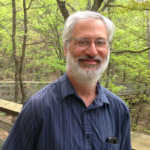 SAINT PAUL BUS TOUR
SAINT PAUL BUS TOUR
St. Paul Neighborhood Networks
This tour was hosted by Lisa Peterson de la Cuenta and Lenna, an Americorps worker with the Computer Technology Empowerment Project (CTEP). The program employs 35 CTEPs, mostly at the workforce centers, providing one-on-one help for people needing computer skills for employment. They also teach media production skills.
The historical core mission for St. Paul Neighborhood Networks (SPNN) was cable access, and they maintain four local access channels on Comcast. The site we visited includes a gallery of art (updated periodically) by local students, classrooms, a youth lab, and access to equipment. Members of the community can pay a small subscription fee and borrow a wide variety of video production equipment. Most of their funding is through a Comcast revenue-sharing scheme and federal grants. In the video production area, they offer a 16-week program to develop a ten minute documentary. Many students come in with no previous skills, but an idea of something they want to create. The program also supports people coming in for as-needed support in video production at a drop-in lab. They also offer a six week summer intern program to produce a documentary. The goal of these programs is to help people find their video voice, and encourage them to pursue careers in video production.
SPNN’s CTEP program is a rare Americorps program focused on working with technology. Within the workforce program, each CTEP helps approximately 50 people per year to receive Northstar Assessment credentials. SPNN also sponsors a Youth Action Committee, which addresses concerns of the local youth. Two successful programs they initiated were to push for a bus stop at SPNN (to help make those borrowing video production equipment to feel safe transporting it) and sponsoring a Queer Prom.
Housed in the same building as SPNN is the Independent Filmmaker Project, which we visited briefly. They work with youth to develop films and encourage film production in Minnesota. The philosophy is that since youth are a large consumer of video, they should have the opportunity to participate in production as well. They offer after school and summer programs.
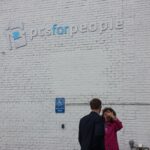 PCs for People
PCs for People
Sam Drong was our host for this visit. PCs for People offers computers, computer repair, and Internet service for low income families (families at or below 200% of the poverty level). For Internet access, they offer $10/month service, with no additional fees or commitment. This has been helpful in keeping people connected, because if they can’t afford it one month, there is no barrier to reconnecting in a subsequent month when they can afford it. They offer free computers, as well as computers at low cost ($30, $50, & $100 desktops, $50, $100, & $150 laptops). They recently entered into a partnership with Midwest Special Services, allowing PCs for People to use their large warehouse for intake and recycling, while providing employment opportunities for people with intellectual and physical disabilities. The revenue from data destruction and e-commerce is sufficient to keep PCs for People self-sustaining, and they use grant money to provide additional programs, such as PCs for Kids.

In 1998, a student in Mankato, Minnesota hacked into the school computer network to give himself all A’s and was expelled. A social worker met with him and gave him an old computer. Six months later, the young man was creating a positive future for himself and others by developing web pages for local businesses and churches. From this seed grew PCs for People. By 2007 they were giving away 200 computers a year. In 2008, under the leadership of Casey Sorenson, they incorporated as a non-profit and started in St. Paul with a supply of 400 computers. Within two months, the computers were gone, and they had a waiting list of 1200. Faced with need on that scale, they transitioned to the model of a data destruction IT business, offering a service to businesses (and local community members) with a net positive social impact all around.
PCs for People operates an on-line store and has shipped to all fifty states (there was a chorus of cheers when the order to Alaska shipped), and works with Tech Soup to provide shipping of their computers. They employ twenty-six people in three sites (St. Paul, Mankato, and Denver). Ten percent of their donations come from individuals, with the bulk coming from corporate and other large organizations. They offer a 90 day warranty on the hardware, and provide phone support, taking 400 calls per day. They also offer repair services for $25 with no additional charge for parts if they have them on-hand. They refurbish approximately 15 laptops per day, and those are typically gone by 2 pm. They serve 200 people a day coming through for hardware, repairs, technical support, and internet service.
PCs for People also offers, in partnership with Mobile Beacon, a program to serve as support for e-commerce where an organization acts as the entry point, but they handle all the work. They currently have 75 organizations using this service. https://www.mobilebeacon.org/bridging-the-gap/. They are working with CTEP to provide office hours for technical support for their clients with computer questions or training issues.
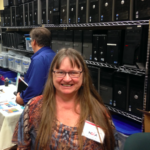 Minneapolis Bus Trip
Minneapolis Bus Trip
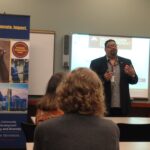 For the Minneapolis bus trip, the first stop was the University of Minnesota’s Urban Research and Outreach. We heard about the Tech Empowerment Center where programs are done in partnership with the university and partners aiming to increase diversity with women, minorities and disabled vendors. Vendors have to use 20% women & minorities to qualify. Some organizations achieve this by donating equipment. As part of their program, The Urban Research and Outreach program refurbishes computers and provides them with the Microsoft office suite to women and minority businesses. People who want a computer must attend three classes before they can purchase a low-cost refurbished computer. They also place medical school students as part of a health initiative, although they mainly partner with other companies to place people after they’ve learned computer skills.
For the Minneapolis bus trip, the first stop was the University of Minnesota’s Urban Research and Outreach. We heard about the Tech Empowerment Center where programs are done in partnership with the university and partners aiming to increase diversity with women, minorities and disabled vendors. Vendors have to use 20% women & minorities to qualify. Some organizations achieve this by donating equipment. As part of their program, The Urban Research and Outreach program refurbishes computers and provides them with the Microsoft office suite to women and minority businesses. People who want a computer must attend three classes before they can purchase a low-cost refurbished computer. They also place medical school students as part of a health initiative, although they mainly partner with other companies to place people after they’ve learned computer skills.
The second stop was Project for Pride in Learning which was started in 1972 for housing. It expanded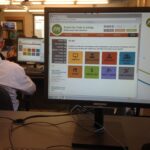 to employment readiness. The website has a hub page which is the base for useful information on a variety of programs. The city of Minneapolis does an annual survey which includes information on digital literacy.
to employment readiness. The website has a hub page which is the base for useful information on a variety of programs. The city of Minneapolis does an annual survey which includes information on digital literacy.
WELCOME AND KEYNOTE
Maya Wiley provided the keynote on “Race to the Future: Digital Equity in a Time of Change.” Maya Wiley is the Senior Vice President for Social Justice and the Henry Cohen Professor of Urban Policy and Management at the New School. She also serves as the Chair of the NYC Civilian Complaint Review Board. Her talk discussed acceleration of technology, broadband access, poverty issues, and the challenges facing us.
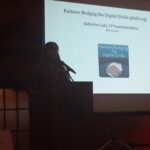 There was a lightening round, where twenty-four organizations had three minutes to introduce themselves. Katherine presented on PBDD, and started with a one-minute stand and stretch break, which helped people remember PBDD from the many presentations. Information on each organization who presented is available in a google doc. It can be interesting to see what other organizations are doing.
There was a lightening round, where twenty-four organizations had three minutes to introduce themselves. Katherine presented on PBDD, and started with a one-minute stand and stretch break, which helped people remember PBDD from the many presentations. Information on each organization who presented is available in a google doc. It can be interesting to see what other organizations are doing.
The afternoon had two breakout sessions with many good choices. Luckily, PBDD had three people attending so we coordinated to get maximum coverage. If the speaker had slides, we’ve included a link to them.
AFTERNOON 2:45 SESSIONS
PANEL 1: Approaches to funding for digital inclusion workforce development.
The moderator was Heather Gate from ConnectedNation.
- Tom Esselman, Connecting for Good, a four year old nonprofit, started right after Google fiber came to Kansas City. Tom had worked at Hallmark, created the music card, and connected with the elderly population. When Tom joined Connecting for Good, they were aiming to increase technology access, building 70 computer labs. Since it was needed, they added training and started receiving grants under the banner of civic engagement. When they were told, ‘we don’t fund technology’, they started down a more intentional path focused on training. It’s important to ensure training results in people mastering a skill. This is needed to align with where the funding is.
- Susan Corbett, Axiom, Maine. Axiom is a last mile broadband provider, focused on rural areas. They hired an educator to help businesses transition to e-commerce around 2006 and started a digital literacy program. A foundation contacted them and suggested they apply for funding. In 2014, they spun off a nonprofit part of the company. They have struggled to get people to understand why Digital Literacy shouldn’t be classified as enrichment, but feel that it’s important that digital literacy is a core skill, not an enrichment. They take the classes to where the people are: libraries, business locations. Bringing classes to business locations was critical.
- Maggie Snow, Anoka County Library. Working since 2008 on workforce programs in the libraries north of the Twin Cities. They have created a digital literacy team in 2015 focusing on adults and seniors and bringing things out to the community. She noted that there has been a sharp decline in people attending classes on basic computer skills recently.
Packaging is important—foundations often say, ‘we don’t fund technology—go to Google for that.’ Changing the language has helped put more diverse programs in place, then got more diverse funding. Banks can allocate up to 1% as a new market tax credit, under economic development, but need to be more elegant than just bringing up the community reinvestment act. Banks like sponsorships, getting their name out there.
Another way to have a bank trigger digital inclusion is to sponsor a hotspot in town—brought to you by X bank. And the terms take you to their web page. Also, banks want their customers to use online banking—this is in Washington county but is probably true elsewhere as well. The Axiom nonprofit can then make a case for basic digital literacy because how can they have an online account if they don’t know how to use a computer? This can be used to procure funding for basic classes.
The panel members also discussed redlining in Cleveland which is getting a lot of attention and happens in other places as well, not just Cleveland.
Session 2: I can’t afford a computer: Acquiring affordable devices
Moderator: Bud Rizer, Cristina Foundation
Speakers:
- Mike Byrd, Kramden Institute. Kramden has been providing computers since 2003 and also provides literacy classes and tech topics. They give computers: to students (nominated by their teachers), to adults (nominated by non-profits, allowing them to buy a computer for $50), and to non-profits for their own use. Most of the computers provided are Linux, which greatly reduces the cost of support, since there are far less virus attacks. They also provide training, and every class they teach is supported by a specific grant.
- James Jack, human-I-T. Human-I-T provides hardware to training programs around the country. Many of the existing programs are targeted to specific niches of recipients (youth, seniors, etc.). Human-I-T wants to target as broad a group of recipients as they can. They are part of a national effort Power-on, which works with LGBTQ individuals and organizations, including the Trevor project. They have been heavily involved in Our Cycle LA, a collaborative partnership with the city of Los Angeles and many corporate sponsors to utilize salvaged computers from the city to reduce electronic waste, provide job training and employment opportunities for individuals with high barriers to employment, and help bridge the digital divide in Los Angeles. They also work with Connect Home in LA, providing computers and wireless connectivity. They sell data destruction as a free service, which many companies are happy to utilize. For the businesses, it isn’t marketed as a donation, but as a service.
- Munirih Jester, San Antonio Housing Authority. SAHA is looking to expand training, working in conjunction with the library system. They provide tablets for youth, based on donations. A consistent flow of equipment has been a challenge, but they now partner with Goodwill, which helps to keep that flow sustainable. SAHA is working to build a digital inclusion alliance in the city, and will be part of a planned google fiber roll-out. They have a program to provide a Sprint hotspot to households which have a school-age youth resident.
Session 3: The Northstar Digital Literacy skills assessment and certification
- Tom Cytron-Hysom gave the history of the Northstar assessment which began in 2008 when several adult education providers and libraries recognized the need for programs to have a standard assessment of digital skills to better own adults looking for employment show their level of digital skills. Stakeholders agreed on the benchmarks and a consultant was hired to develop the on-line tool. Use of the assessment grew very quickly to the present 400 sponsor sites all over the US. Each sponsor site pays a fee (depending on organization budget) to officially offer the assessments and certificates. The on-line assessments are also free to the public which has now tallied over 1.5 million assessments. Tom estimates that each module/set of benchmarks costs between 5 and 10 thousand dollars to develop. Future plans include having multiple forms of assessments for each module.
- Adam Strizich, presented his work with the Martha O’Bryan Center where he teaches digital literacy. He described their most successful class cohort of adult learners living in public housing who met 4 times a week for 1 month with 2 instructors. Learners were given child care vouchers. Each learner took the Northstar assessment at the start of the class. Results were used to develop an individual learning pathway shared on google drive. Once learners complete four modules, they were given a laptop and eligible for a rent freeze through HUD housing. Adam has also developed and will share the correlation of Northstar assessment benchmarks and learning materials that creates the individual learning pathway.
AFTERNOON 4:00 SESSION
PANEL 1 – I can’t afford internet service: finding low-cost broadband offers (other than Lifeline)
- Moderator, Martin Ludden, SPNN – St. Paul Neighborhood Network.
- Katherine Messier, Mobile Beacon, no link to slides – founder and executive director. Bridging the Gap provides individuals and families below the 200% poverty level with broadband access for $10-13 a month. The goal is to provide mobile Internet access– anytime, anywhere, unlimited data. No 2nd class internet. They conducted a scientifically designed phone survey in Dec. 20th – Jan 2017. 73% of respondents had never had a home internet connection. Now 94% are daily users. 32% began taking online classes since enrolling. Those taking online classes use 19 GB more data per month than those who do not. If you enable entire households to use the internet without caps, they will use it for things such as further education. Nonprofits and community anchor institutions in 47 states have partnered with PCs for People and Mobile Beacon to Bridge the Gap. It allows local organizations to offer and publicize the service without incurring the overhead. To sign on, click here.
- Alyssa Kenney, DANEnet – Madison, Wi. Slides. Founded in 1995. Used to run bulletin boards. Have four low-cost opportunities, but people don’t know about the options. DANEnet works across a lot of groups. Do IT support for 160 nonprofits, fixit clinics. Carry the sheet on how to get low-cost internet everywhere they go. They host enrollment events. It’s important to bring all the right tools and all information, everything people need to get their documentation so they can successfully apply on the spot. They bring a Mobile Beacon hot spot. They bring computers and have them show different speeds. People need to see it to make informed decisions. They have found that hosting tables at events and community festivals was a waste of time. Providing food and childcare was not needed. Don’t need to make the workshops long. Cultural competency is more important than tech skills. Find people who understand the low-income community and how the low-cost connection will save money. Bi-lingual staff (Spanish and Hmong) are critical in Madison. They do mostly paper flyers, library event calendars. They do a workshop outside the library when the library has a staff day and is closed—find the people who are outside using the internet. They call it internet for low-income families.
- Kelly McCarthy, program director for Tech Goes Home Chattanooga. Slides. Have a survey on connectivity. Based on Tech Goes Home Boston. Finding their way on how to get information out there. They have five low-cost options. Some require a student who qualifies for free lunch, so had to work with the county ahead of time to see who qualifies. Have parent tech nights in their one-to-one schools, where kids get a device for the school-year. There are reasons you can be turned down for low-cost internet plans and they’re complicated. So they work with Comcast and others so people can get Internet Essentials. Once they had the sheet of alteranataives, they could go over and fill out their application. Signed up 120 families over the course of eight events.
- How did they get the ISPs to come to their events? ISPs are looking for ways to partner with the communities in a meaningful way. Reached out to the Regional Rep for Comcast. They do want people to enroll in the internet essentials so they agreed to attend.
- Designed a survey that they could take which would show them which ones they don’t qualify for or didn’t meet their needs. So they’d take the few-minute survey that narrowed the options. Also had questions about how much data they needed, so they estimated the data usage for email, browsing websites, streaming videos.
- Norma Fernandez, EveryoneOn. Slides. National level and the local level, around since 2012. Working with wireless and cable internet providers. Have regional managers. Critical to work with diverse organizations. 687 enrollment partners. Offer locator tool. Digital Equity Champions are the individuals, departments and organizations who work with low-income people and families at various eligibility touchpoints. Get them to ask people ‘do you have internet service beyond a cell phone?’ They have a website, short message service, interactive voice response system, mobile app – tool to give zip code, answer eligibility questions to get low cost internet service and computers.
PANEL 2: Innovative community applications of familiar broadband technology
Moderator: Luke Swarthout, New York Public Library
Speakers:
Mark Erikson, RS Fiber. I apologize that I entered this session late due to the cancellation of another session, so I missed Mark’s introduction.
Casey Sorensen, PCs for People. In addition to the information from the bus tour, Casey shared that PCs for People has met 40% of the estimated need for equipment and connectivity in Minneapolis/St. Paul. 85% of ISP users stay with them, due to the low cost and low barriers to entry/re-entry.
Ray Savich, Cambium Networks. Cambium networks provides the ability to get high speed from a tower, helping serve rural areas for lower cost than running wires. There are many products that can meet a range of needs with regard to range, cost, speed.
Houman Saberi, Resilient Communities, New America. RISE : NYC comprises six neighborhood wireless networks built in partnership with New York City’s Economic Development Corporation (NYCEDC) and community-based organizations in Sandy-impacted areas. The Resilient Networks will bring storm-hardened broadband connections to small businesses and provide a platform for training local residents to install, maintain, and leverage wireless communications infrastructure for preparedness and other community goals. Fallback of local communications if internet connection is down or slow- allows local connectivity at high speed.
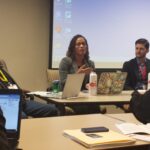 A key question to ask is “What can broadband fiber do for your community?” Community involvement is a key to building it. It is necessary to provide the motivation to acquire technology, funds, and training. Consider addressing local problems, and introducing the technology to help solve it, rather than try to introduce technology, then sell uses for it.
A key question to ask is “What can broadband fiber do for your community?” Community involvement is a key to building it. It is necessary to provide the motivation to acquire technology, funds, and training. Consider addressing local problems, and introducing the technology to help solve it, rather than try to introduce technology, then sell uses for it.
PANEL 3 Approaches to funding for digital inclusion: Working with philanthropy
Moderator: Laura Breeden, NDIA. Themes:
- Use hyper local funding as a best fit for many community based organizations and projects.
- Cultivate relationships with local foundations and philanthropists.
- Have sustainable plans and multiple funding streams.
- Use the foundation’s vocabulary to present your program/s (e.g. ROI, educational attainment, increased employability)
Panelists:
Leon Wilson, Cleveland Foundation is the oldest and fifth largest US community based foundation. Their three general parameters for choosing programs to fund are: 1. Organization/project with goals that align with Foundation mission 2. Specific community responses to issue with clear measurements for proposed project 3. Out of the box new ideas.
Bernadine Joselyn, Blandin Foundation is a private Minnesota-focused foundation with a focus on community leadership development. When people show up to programs and return, that is a good indication of effective potential. “Change follows relationship development at the level of trust.”
Aretha Green-Rupert, Otto Bremer Trust was established in 1944 and serves three states: Minnesota, Wisconsin and North Dakota, where Bremer Banks are located. Focus on leveraging what is on the ground already.
DAY TWO
Then, onto day 2! Wednesday morning began with breakout sessions. And since we were all starting in the same building, we got someone to take our picture together.
8:45 Session
Panel 1: Varieties of digital literacy training: Same goal, different approaches
This session was moderated by Amy Sample Ward of NTEN, and was attended by about 25 people, overfilling the room. Most were involved in training, with a couple of ISPs in attendance. The speakers were:
Kami Griffiths, Community Technology Network. CTN focuses on training for seniors, serving twenty six senior centers, mostly on a drop-in basis. They have found structured classes to be a challenge, with their requirements for continuity of attendance. They also have an an-home iPAD program, and offer a class comprised of three two-hour sessions, at the end of which they provide a free laptop. These classes are limited to twelve people.
Tom Hackbarth, St. Paul Neighborhood Network. Tom discussed the SPNN media production classes. See bus tour (above) for more details.
Wanda Davis, Ashbury Senior Computer Community Center. ASCCC tries to take a holistic approach to their introductory computer training, starting with socializing to get the participants comfortable with each other and the instructor. Wanda described it as a 12-15 person jam session. Once they get talking, she keys in on what they are saying, and raises potential for technology enhancements, such as for communicating with grandchildren via Facebook or Skype, sharing pictures via Dropbox, etc. Their Fundamentals class lasts eight weeks, and 70% take follow-up classes to continue to learn. For students who attend multiple sessions during the curriculum year, they offer a graduation ceremony, which is a strong motivation for some students. They have partnerships with PNC bank, Mobile Citizen, and Salvation Army, which supplies computers. They also work with DigitalC’program in Cleveland which works with Cuyahoga Metropolitan Housing Authority to bring households online, providing devices for each household, and providing digital literacy and job training.
Lisa Peterson-de la Cueva, St. Paul Neighborhood Network. Lisa manages the CTEP program for SPNN. They work with community centers to provide training, focusing on employment skills. See bus tour above for more information.
Cache Owens, Charlotte-Meckelenburg Housing Partnership. CMHP has branched out from a focus on housing to include digital inclusion in the last nine months. Their digital inclusion falls into three categories: Sneaking it in to existing classes, like financial literacy, to discuss on-line banking; dedicated digital literacy classes, semi-weekly classes for three weeks, at the end of which the students can purchase a laptop for $25; drop-in labs, which they offer at various sites (using a mobile lab setup) to bring the technology to where the people are.
Some organizations that provide training have found a revenue source in providing training at for-profit housing developments, which they can use to raise funds to help support training for low income housing. Engaging seniors works best when organizations partner with them, listening to their needs and interests, and determining how tech can help.
Funding sources for training: grants, foundations, public, private, fee for service, asking for donation with scholarships for those who can’t afford it, build relationships with organizations and ask from a wide selection of potential supportors so 10% return is helpful. Walmart & Dollar General were two orgs mentioned as providing local grants to many communities.
PANEL 2: Digital literary and critical thinking
Jen Vanek, Moderator, University of Minnesota pointed out that the goal is to have technology be a bridge not a barrier. Out of 5,000 people, 13% couldn’t take the digital literacy part of an annual survey done in Minnesota. US had the highest number at the lowest skill level. Despite spending 35% of their time online, 58% percent of millennials tested at the lowest level in a 2012 study with follow-up in 2014. PEW research about why – largest reason is they don’t see the relevance in their lives. Need to not just make digital literacy available, but push people to learn how, when, what for. Critical digital literacy.
Jessica Jones, MN Literacy Council, teaches Adult English for new immigrants and refuges. Some not so new. Started working at a small nonprofit on the South side with no teaching experience. Idea being—you know how to use Microsoft word, so you can teach it. Posted material online. Thought it was great. When clients got their own computers, they came and said, “I can’t use this. It doesn’t have X.” Shift in thinking, need to teach computers as problem-solving. Almost always have students paired so they have to clarify their thinking and communicate it. (Teach advanced ESL.) Concluded that it was better to have fewer demonstrations, don’t show things step-by-step. Instead, build conceptual knowledge. Subject line in email—how is it like a title of a book. But don’t show the internals of email. First task, paired together, send me an email. Then, she walks around the room and asks questions. Like ‘what are you trying to do? What have you tried? What do you see on the screen that might help you?’ Trying to teach students to scan the whole page to look for things. Practice in class where students share what they know with each other. Have students work together is her big take-away. It fosters the problem-solving and communication that will help with technology and more.
She did a programming app with her students that was about directions. First went over the directions, left, right, etc. Paper and demonstrations, then paired people to do the coding app—they then had a reason to use their new language to create the program—had fun because they had a purpose. Often people are shy about using their new language.
Madison Neece, St. Paul Neighborhood Network, serve non-native English speakers. Started teaching beginning computer skills in 2015. Students have to rely on communicating with each other. The instructor isn’t the one who has all the answers, that’s not her role, not her place. Building community knowledge based on the technology that they have—smart phones, or the occasional computer in the home. Ask students—what is the purpose of this website? Who was it made for? Mentioned the Digital Homeroom for low literacy students to learn computer skills. Evaluation Rubric for online resources – are different learning styles accounted for? Quality of the exercises and skills? Applying critical skills herself and teach students to identify websites that are no good.
Mark Danaro, Infoxchange.org/au (from Australia). Technology for social justice. Worked in corporate world and then became an educator. Worked in Thailand with disadvantaged students for a year—different view on how people should be learning, enterprise education at a boarding school. Engaging people with different abilities (having the boarded students work with adults 4 out of 7 days of the week) improved critical thinking. General question is who uses technology without understanding it. Asked someone who is on the phone all the time where her email goes. “I don’t know.” People who are comfortable not knowing. It’s important to inspire people to slow down and think about things. A lot of challenges they see in Australia are social challenges, not technology. Losing the art of conversation.
One of the panelists asked the audience what people thought the session meant, especially the critical thinking part. Some answers:
- ‘When people learn to code, they learn to problem solve.’
- ‘How to teach problem solving. Getting people to understand that it’s important to know how they got to the solution.’
- ‘I’ve been a critical thinker all my life since I grew up poor in Brooklyn and had to use problem solving to make ends meet.’
- “How do we teach librarians to teach others about critical thinking?’
Panel 3: What are we accomplishing? Approaches to digital inclusion program evaluation
Samantha Schartman-Cycyk Connect Your Community (standing in for Mary Ann Van Cura)
Shauna Edson, The Salt Lake City Library, presented (slides) her work in Salt Lake city which is currently developing a city-wide technology inclusion plan. The library took the lead in a community needs assessment which informed the development of a one to one tutoring program. Impact and outcomes are measured with individual surveys. Her work in ethnography also showed how groups may access services at one organization/location but be hesitant to go to other providers. She recommended teaching the use of Google Drive so that people without devices have device autonomy.
Matthew Timberlake, Multomah County Library in Oregon, presented(slides) how the county convened stakeholders in 2014 to develop a community coalition called DIN (Digital Inclusion Network). Their work together resulted in a 3 year plan focused on five main goals and 17 milestones. Each partner organization is assigned specific milestones to measure. In some cases, participant surveys are administered pre, post and 3 months post to track impact.
Colin Rhinesmith, Simmons College, presented(slides) the results of his research and the published report Digital Inclusion Outcomes-based Evaluation. The main recommendations include: Developing shared vocabulary, indicators and data elements; Engaging other stakeholders in digital inclusion; creating a robust on-line tool and resource. A digital equity logic model is included in the report.
10:00 Sessions
 PANEL 1: Great materials and tools for digital inclusion training
PANEL 1: Great materials and tools for digital inclusion training
Moderator, Matthew Kopel, NDIA
Scott Allen, Public Library Association, slides. Public libraries create possibility. Trying to develop programs for 17,000 libraries. People expect libraries to provide internet access and teach digital literacy. DigitalLearn.org – 2012, IMLS grant to develop and launch website. 19 modules, video with narration. Basic low-level. Cautious Clickers is one of the categories. They add 2-4 courses a year. They worked with the Chicago Public Library to stand up their own site to show impact on their community. Can add personalized information with specific, local resources. Built in back end data of analytics pages. Can show courses being completed. Minnesota was dark blue—due to a survey that links to the library pages. Encourage libraries to stand up their own sites. So encourage people to involve their local library.
Steve Black, TechBoomers.com – gave origin story. Since they’re a partner who has been profiled, can read about them here. Goal is to create the largest library of training material. They share their content for free. People provide great feedback. Creative commons license for their materials. Can track your progress, but don’t have to, which can be a benefit since new computer users are cautious about sharing information.
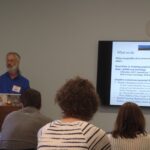 Barry Glicklich, Partners Bridging the Digital Divide, PBDD.org, slides – friendly introduction since Barry worked on the NDIA conference at the national level. He shared tips for getting started. Mentioned white papers and went through what has been learned. Gail’s toolkit mentioned—framework for putting together a course. Gather instructors on a quarterly basis on a local level and learn from each other.
Barry Glicklich, Partners Bridging the Digital Divide, PBDD.org, slides – friendly introduction since Barry worked on the NDIA conference at the national level. He shared tips for getting started. Mentioned white papers and went through what has been learned. Gail’s toolkit mentioned—framework for putting together a course. Gather instructors on a quarterly basis on a local level and learn from each other.
Panel 2: Community Network User Metrics: What some community providers are learning from the people they serve
Moderator: Samantha Schartman-Cycyk, Connect Your Community, slides
Jo Ana Alvarado, San Antonio Housing Authority, discussed their installations of access points to provide 24/7 internet access to residents of two housing authority locations. In addition, community digital ambassadors (trained residents) train others living in their communities.
Rick Deane, founder of Connecting for Good, emphasized the creation of communities based on mutual respect. Their training programs focus on three areas: career, life and education. Kansas City is creating a common curriculum for 70 agencies.
Cassie Bair, Mobile Citizen discussed the business model they use to provide connection and devices to communities. they use the Sprint network and average cost is $10/ month. Resellers are 89% of their business. Most users average 76 Gigs per month. Direct customers are usually organization/non-profits using connection internally (e.g schools).
12:30 Evolution of the Digital Divide, A conversation
John Horrigan – PEW – Mark Danaro, Infoxchange. Working on founding an Australian Digital Inclusion Alliance. Mark stresses Access, Affordability, Attitude. Mark sees the United States as mainly focusing on access. Asked John why—John said it was partly the American desire for shiny new things. John uses relevance, not attitude. Talking less about it today than we did 8-9 years ago. Migrated to digital skills being an important issue. How do people learn how to trust. Trust and privacy are hot topics.
This was followed by the closing plenary on Local Government Investments in Digital Inclusion Video Recording is available on Facebook – (Thanks to Digital Charlotte.)
CONCLUSION
Overall, this was a worthwhile conference. We encourage partners to attend the next one. You can watch our conference page for information on it and other conferences.
- Net Inclusion 2017 Slide Show of Affiliates (created by CTEP Member Kevin Mercado)
- Panelist slides and links are available within each session
-joint report from Katherine Lato, Barry Glicklich and Maryanna Milton
